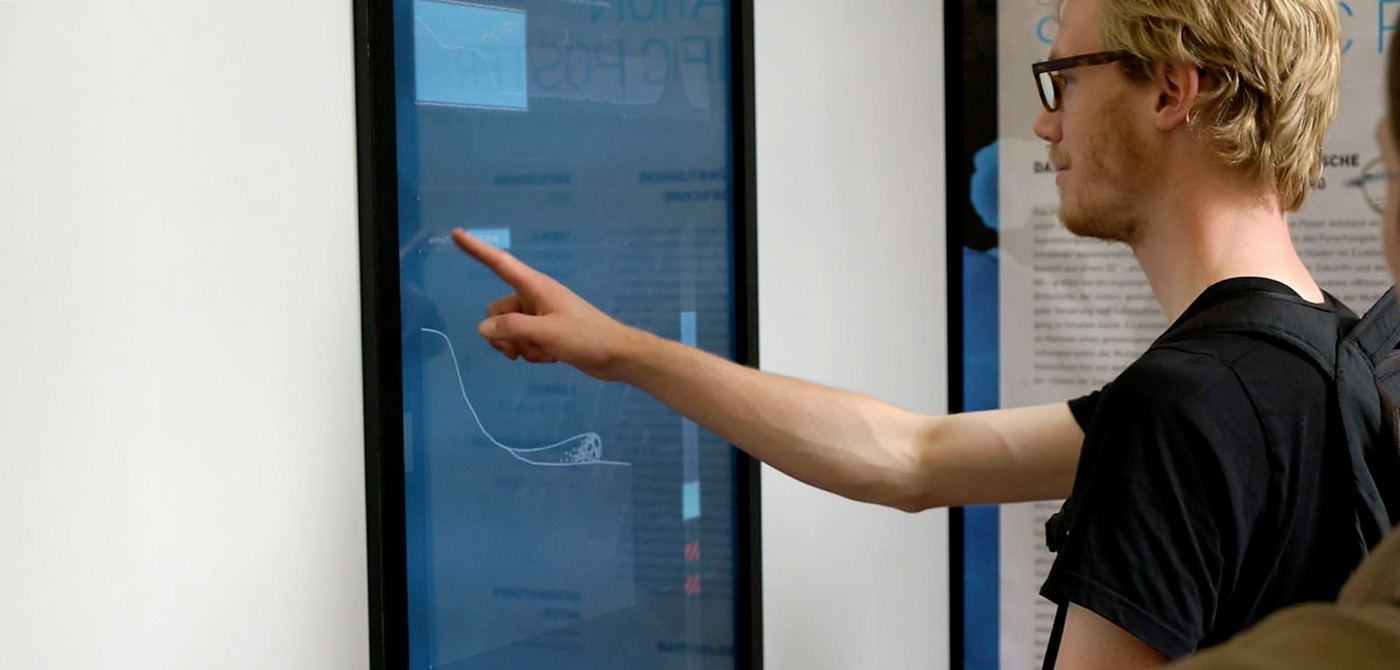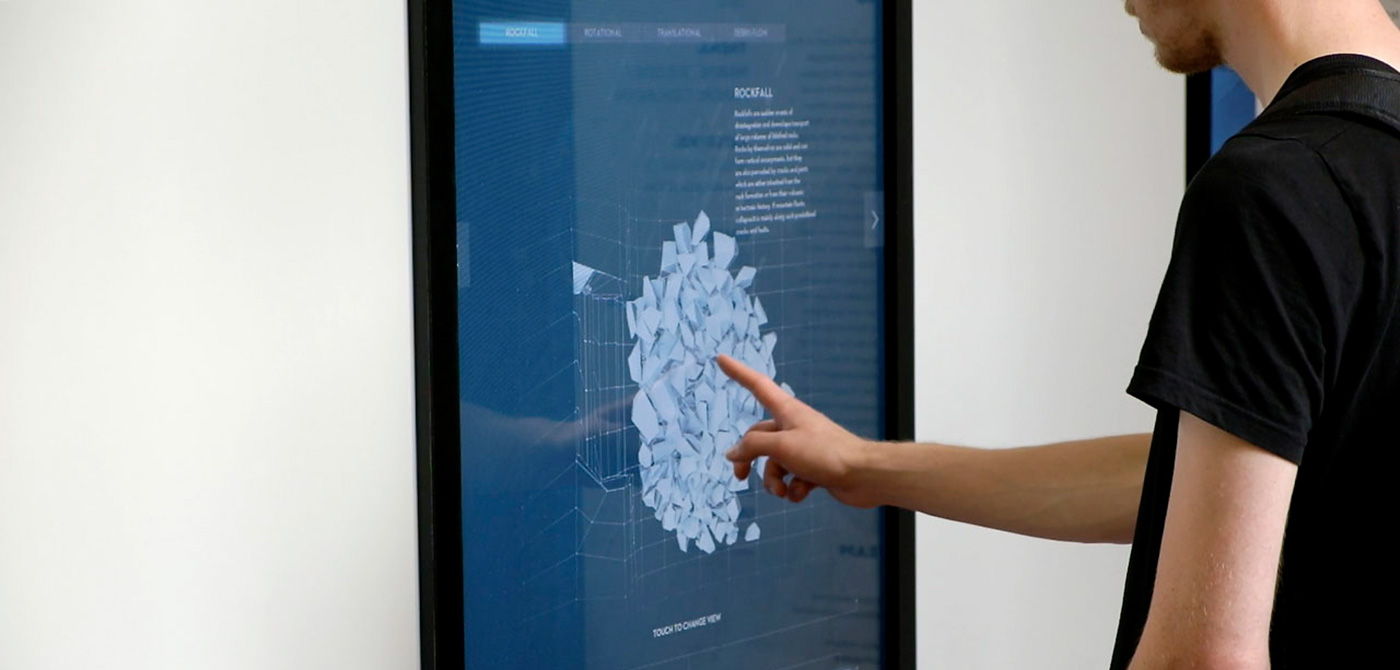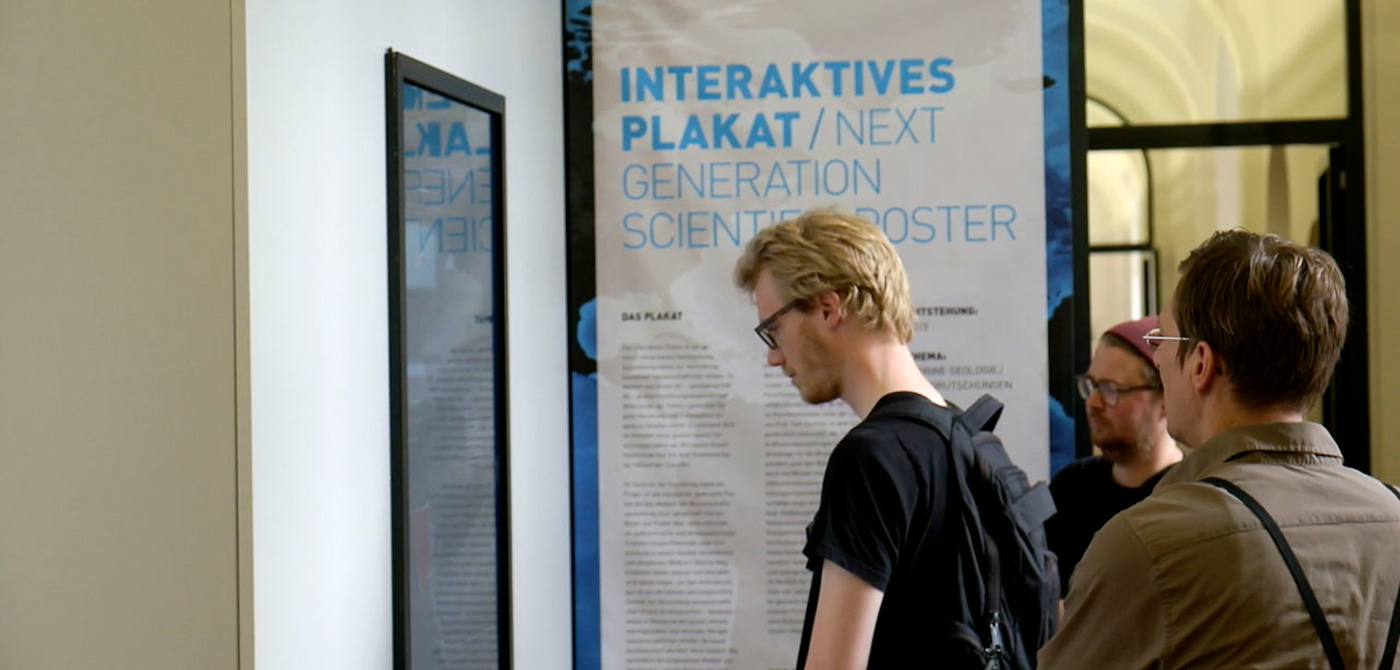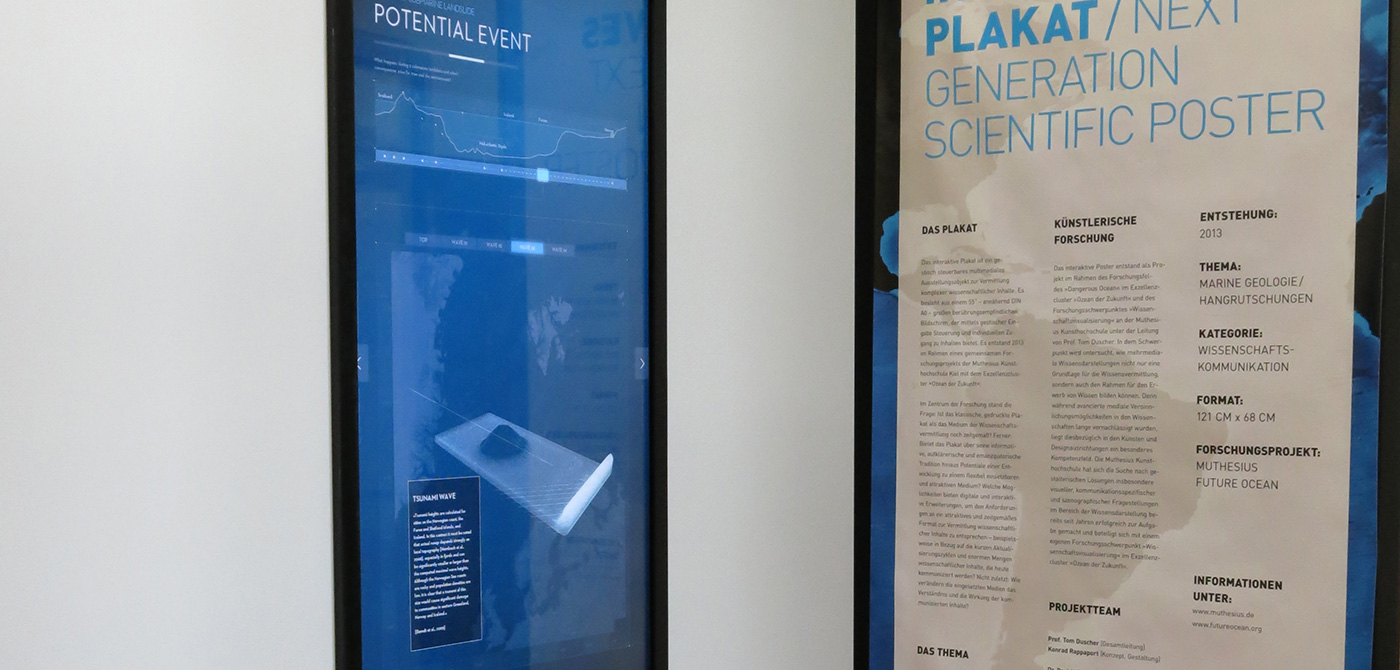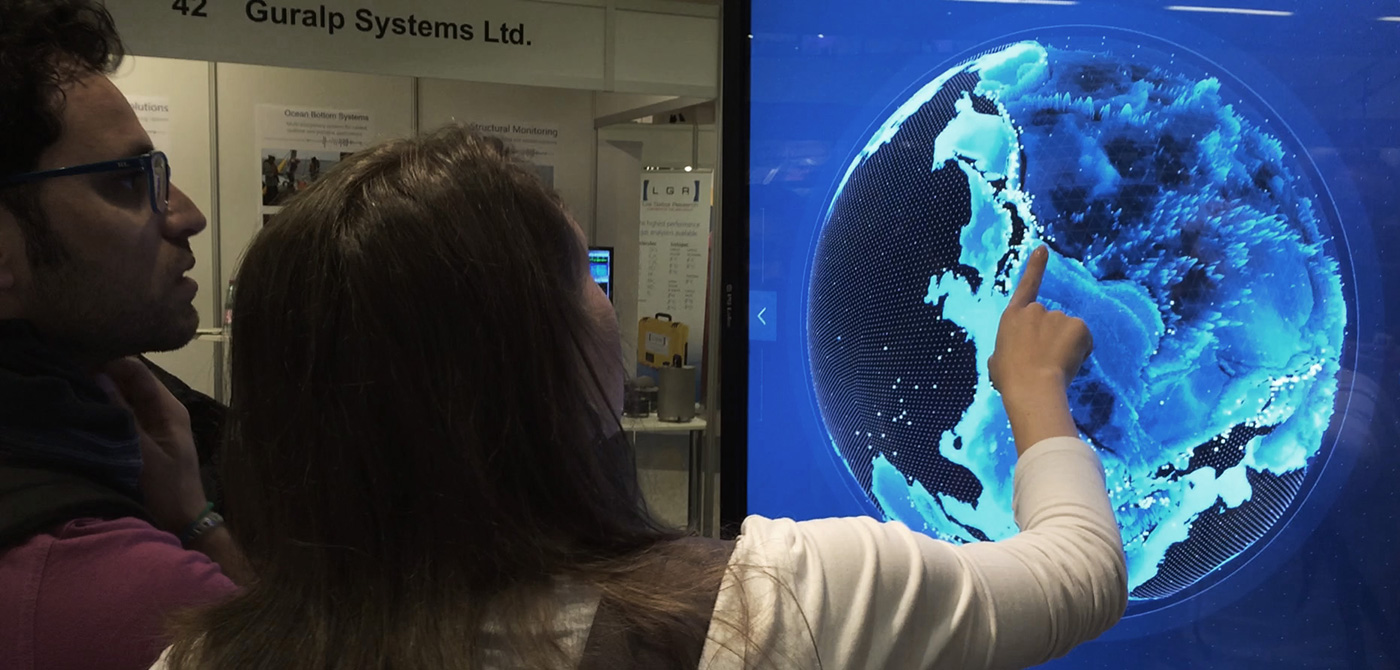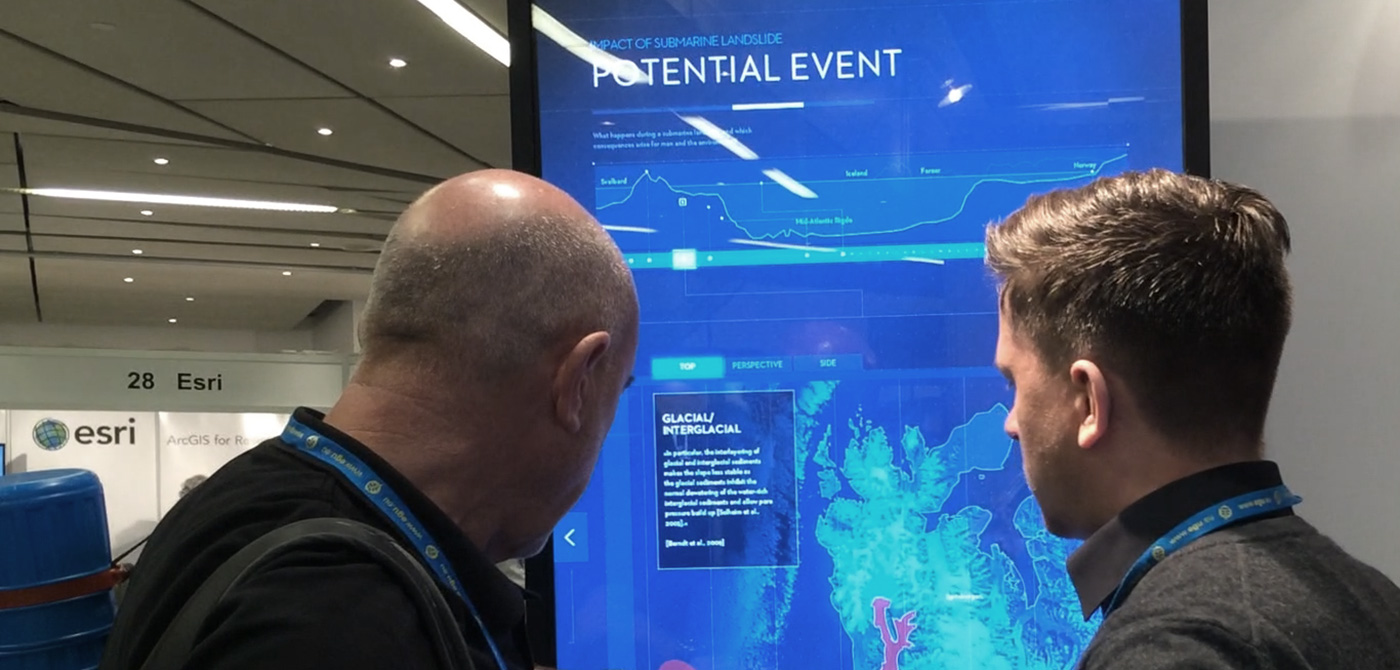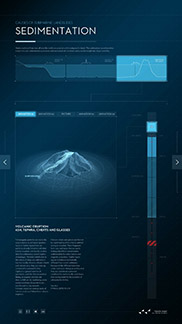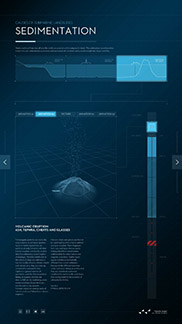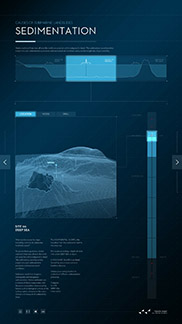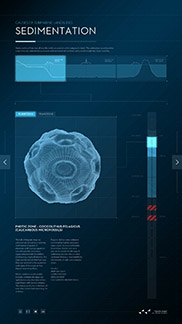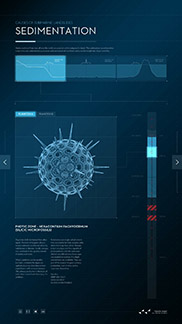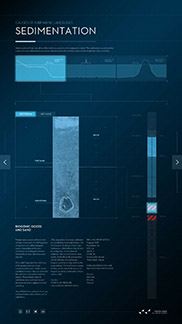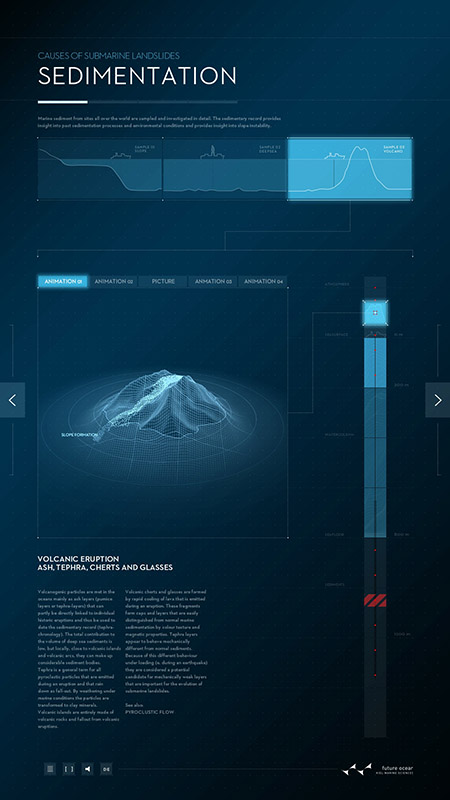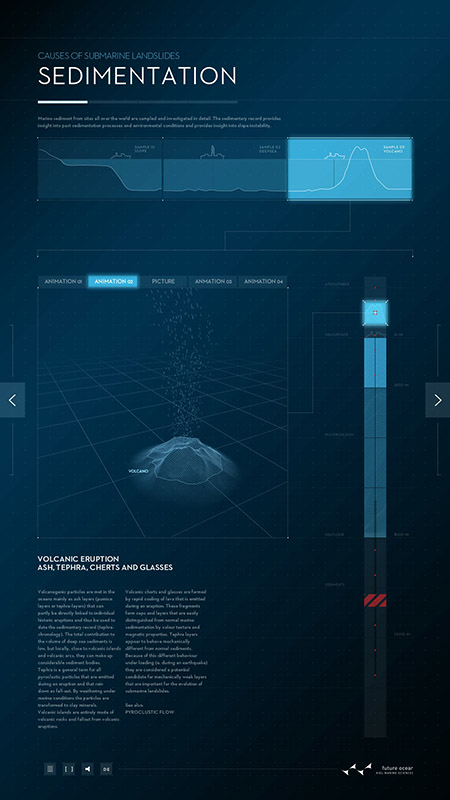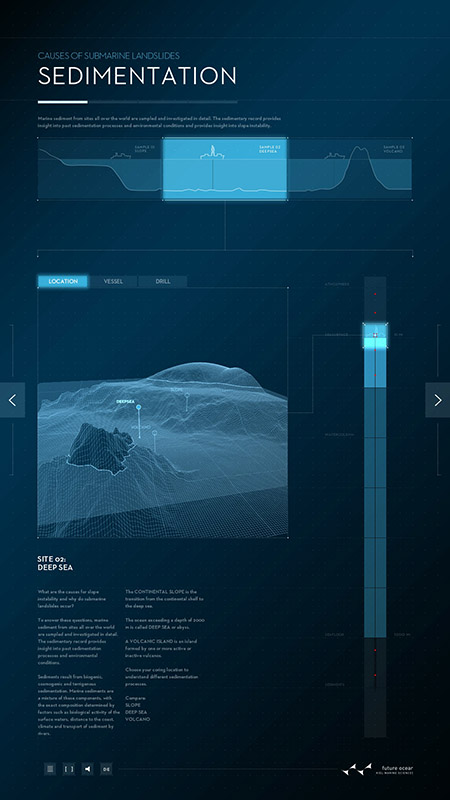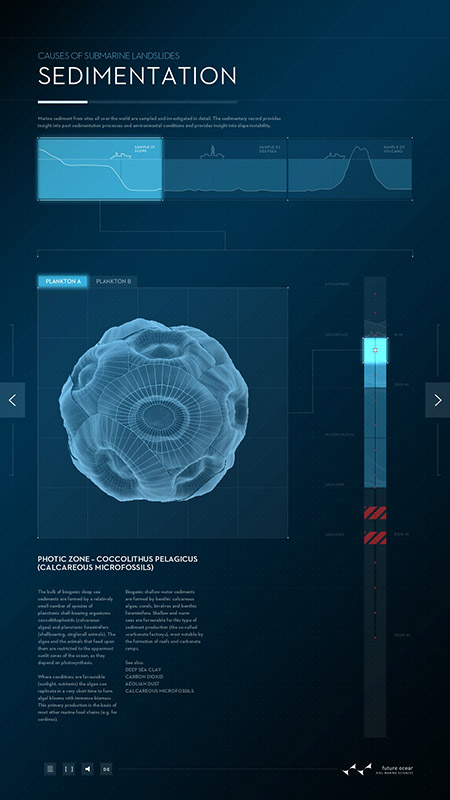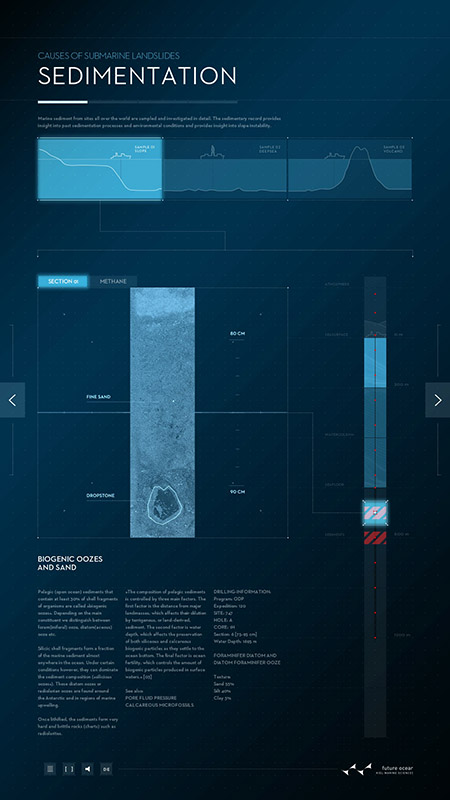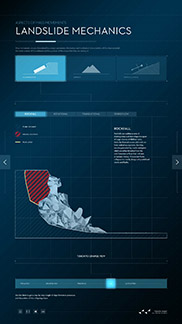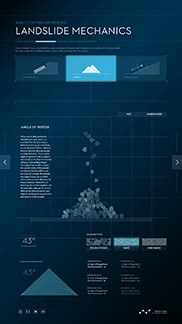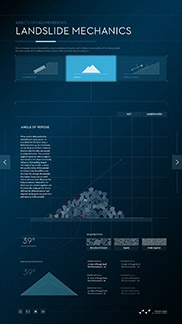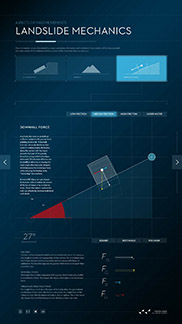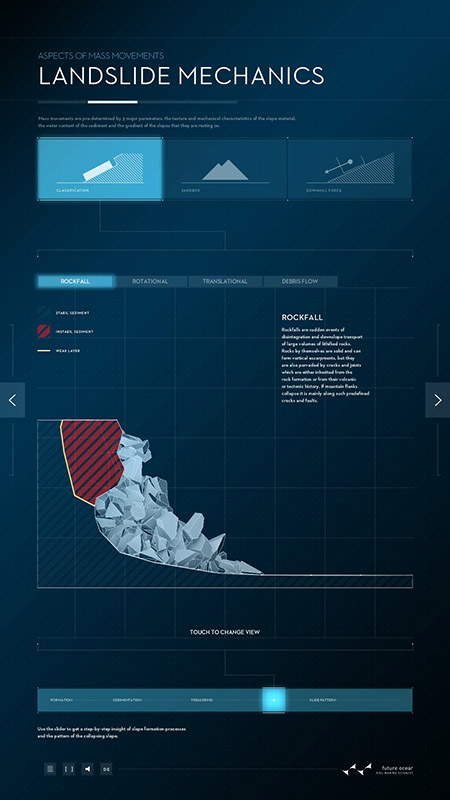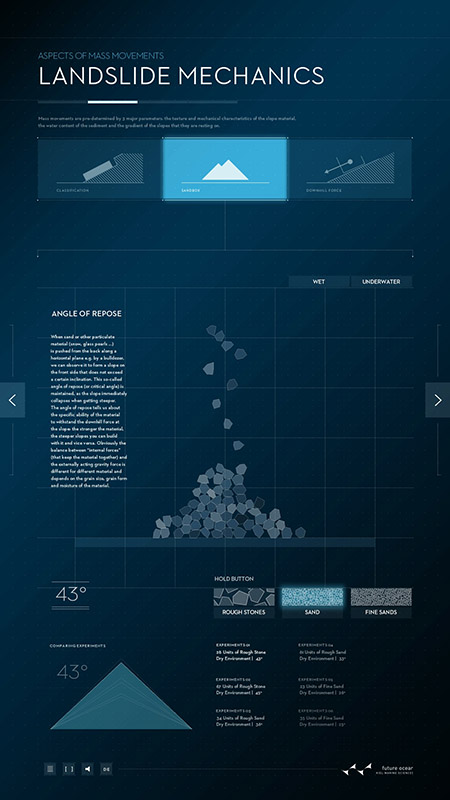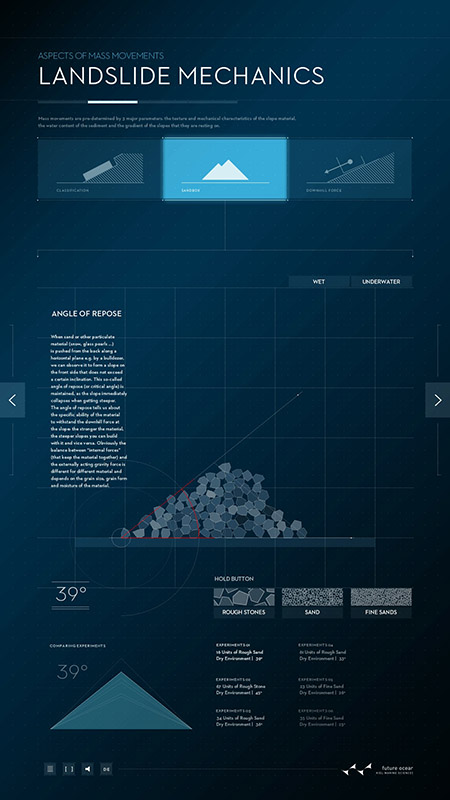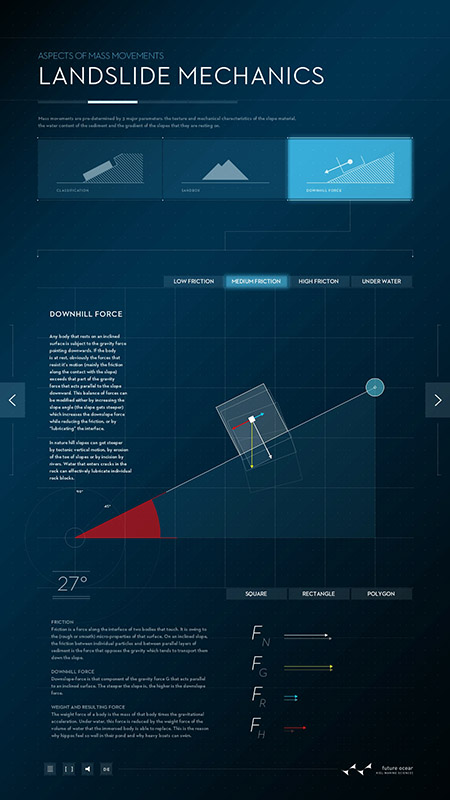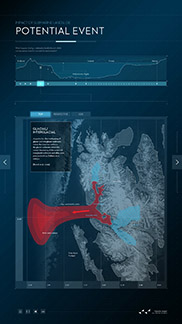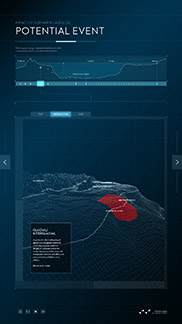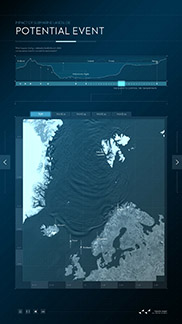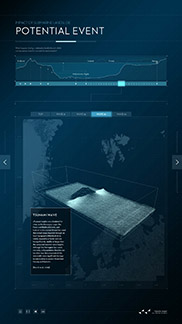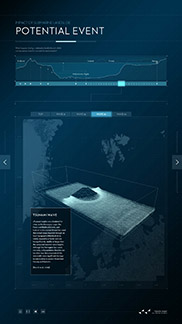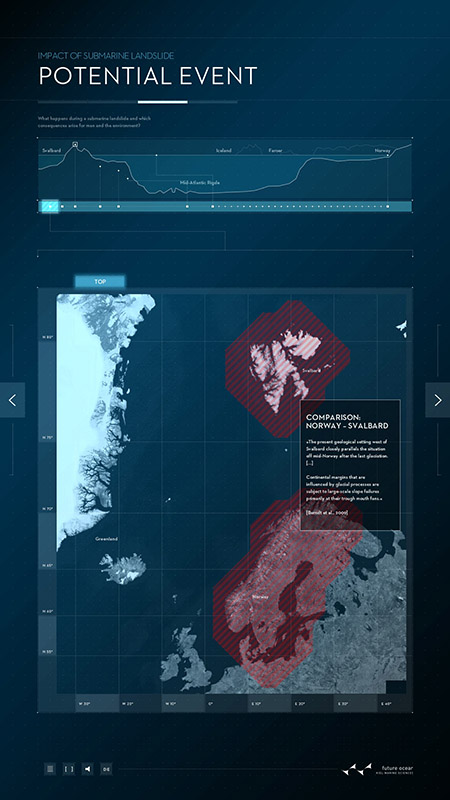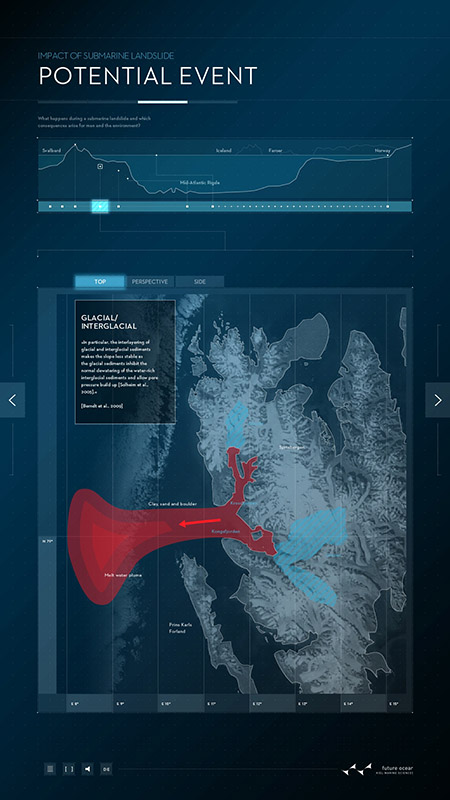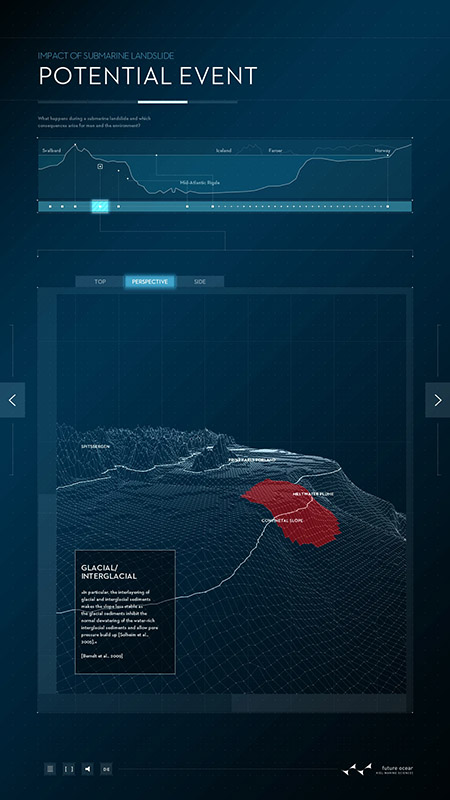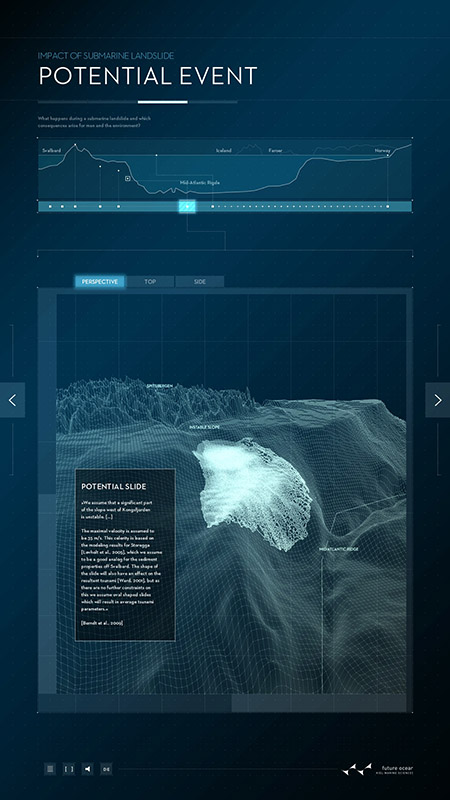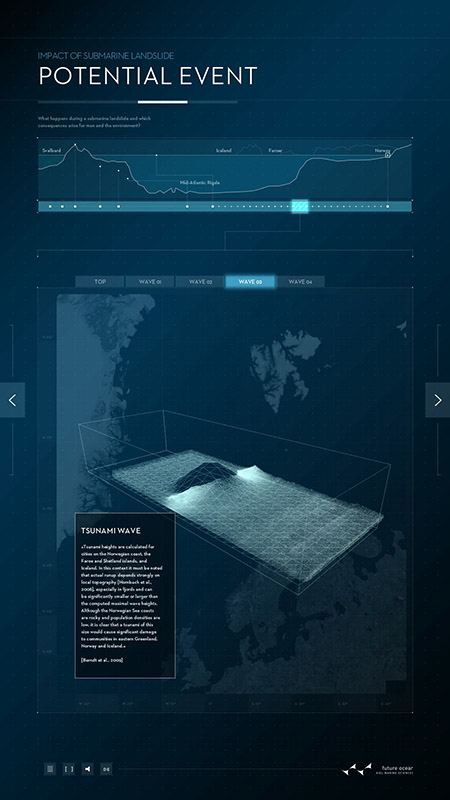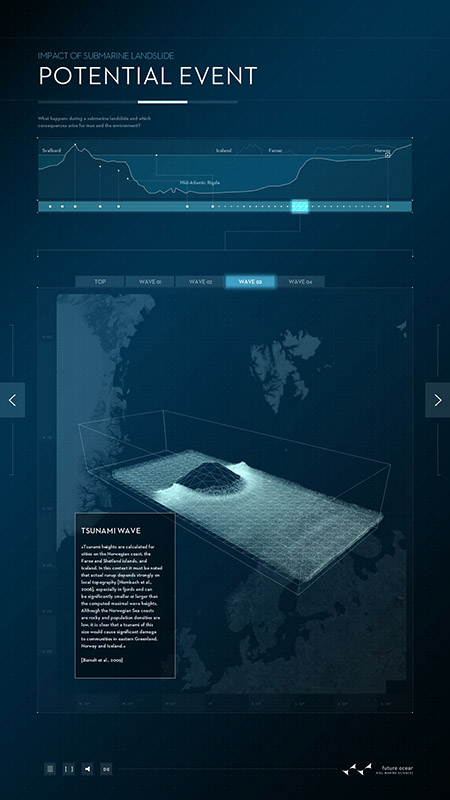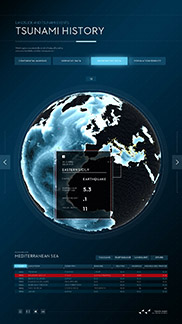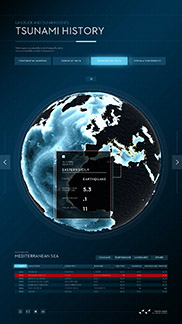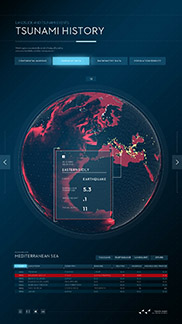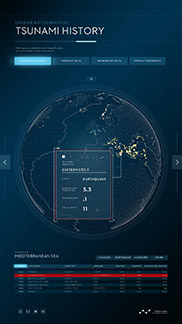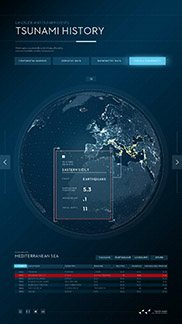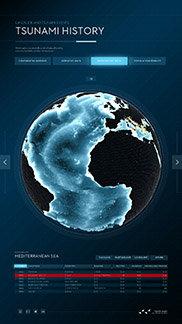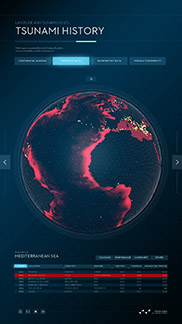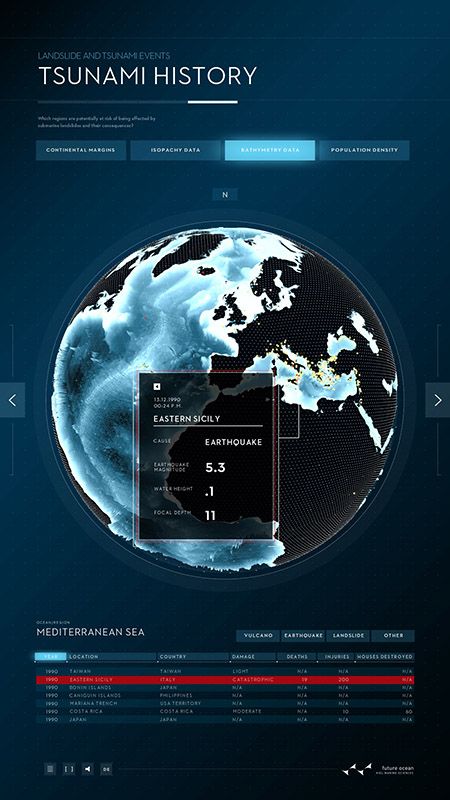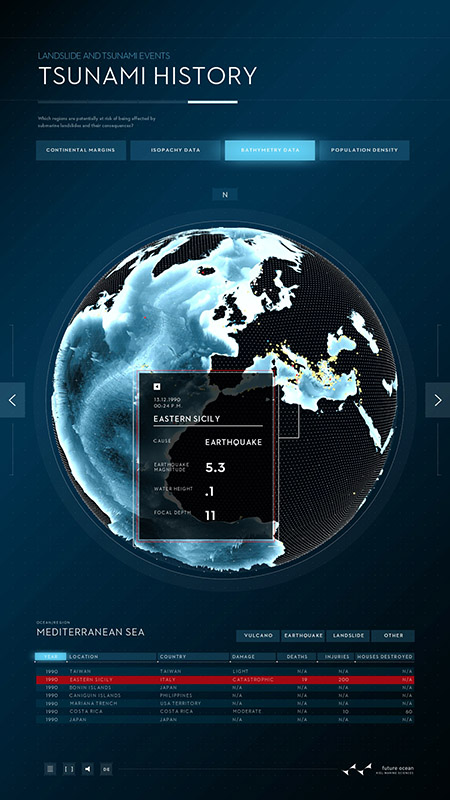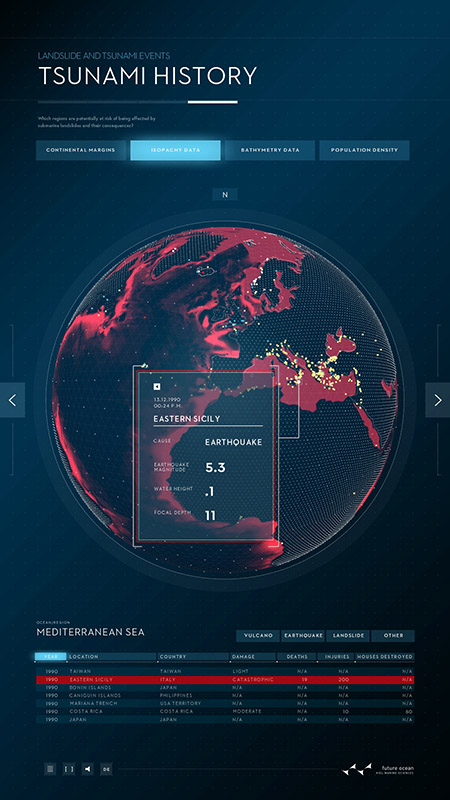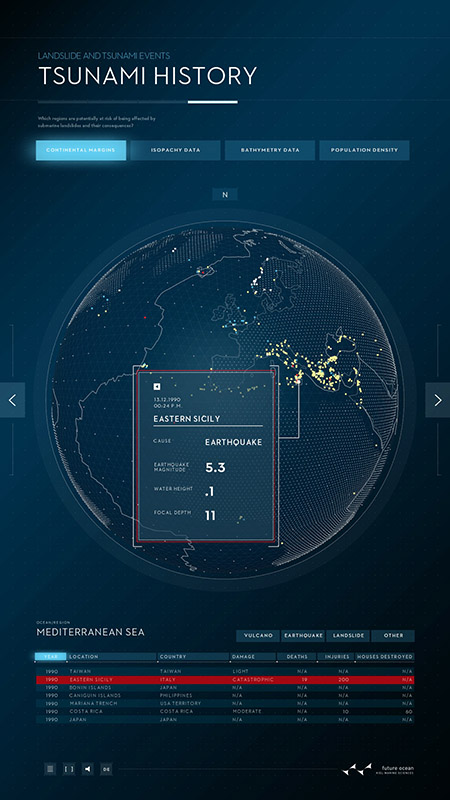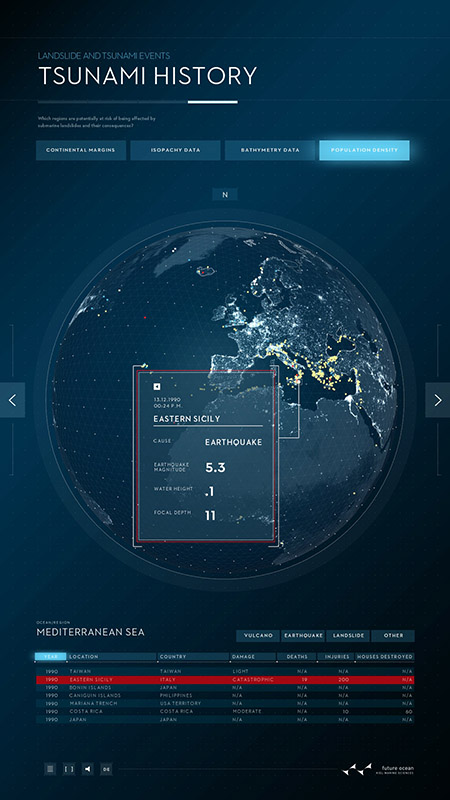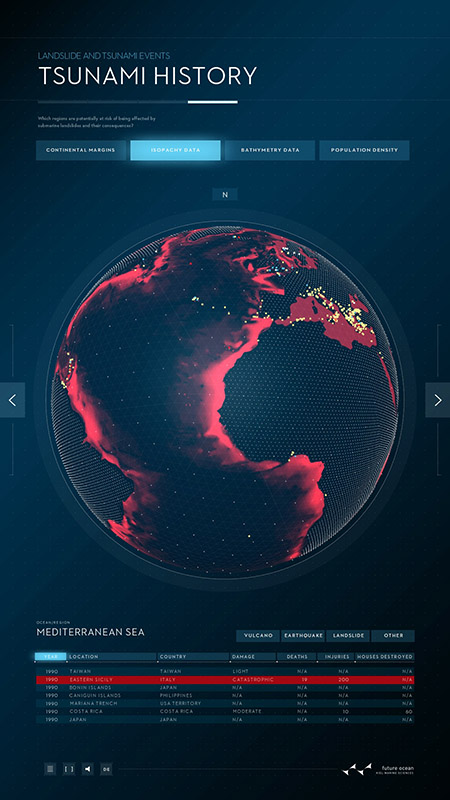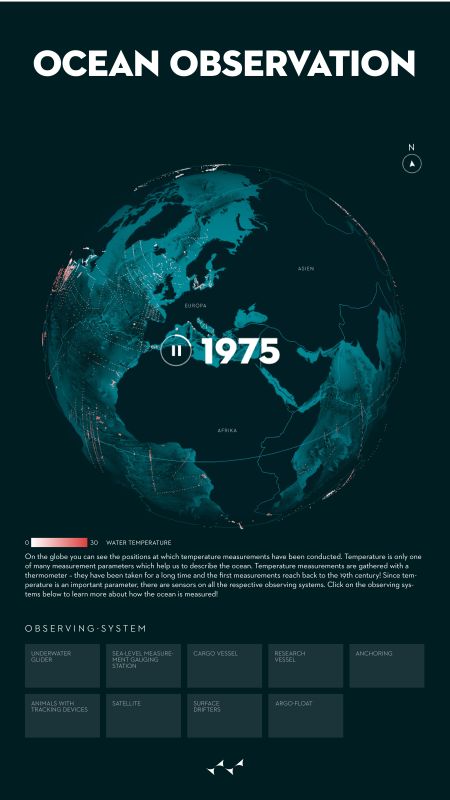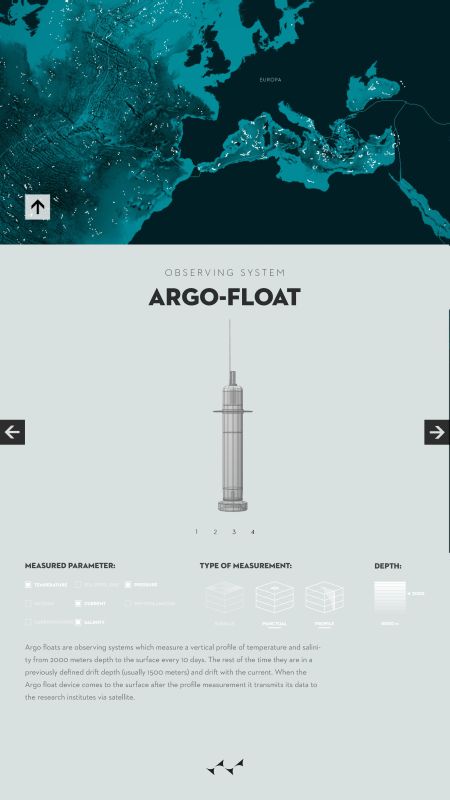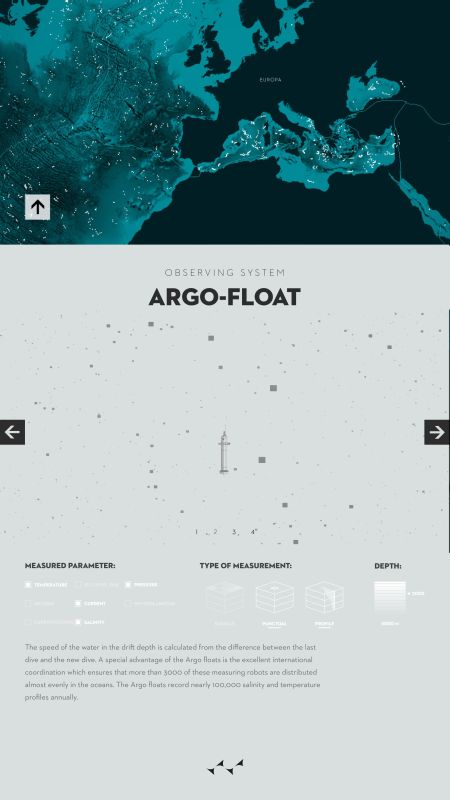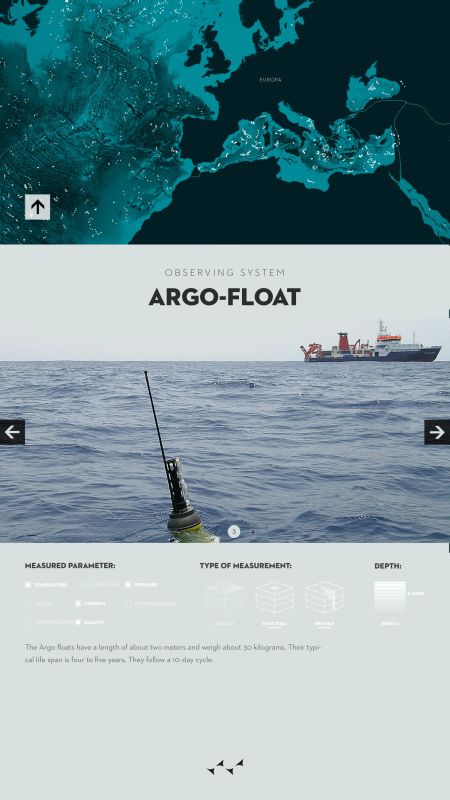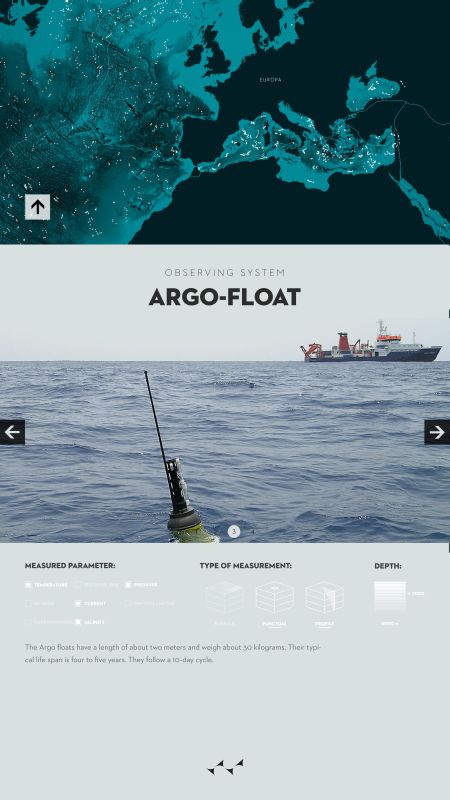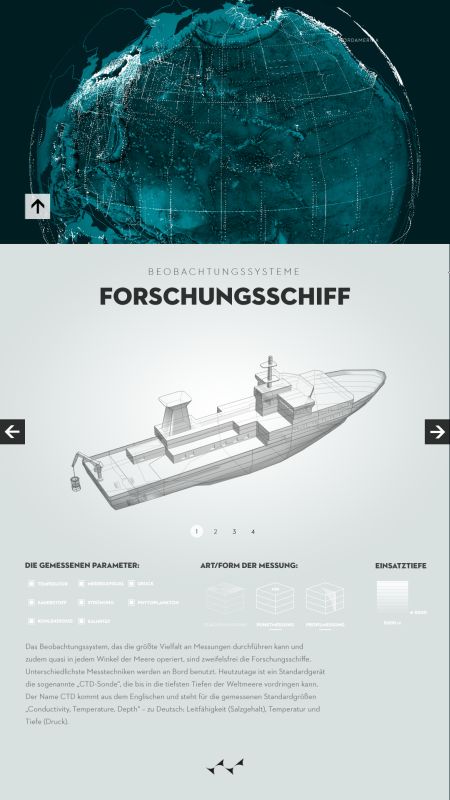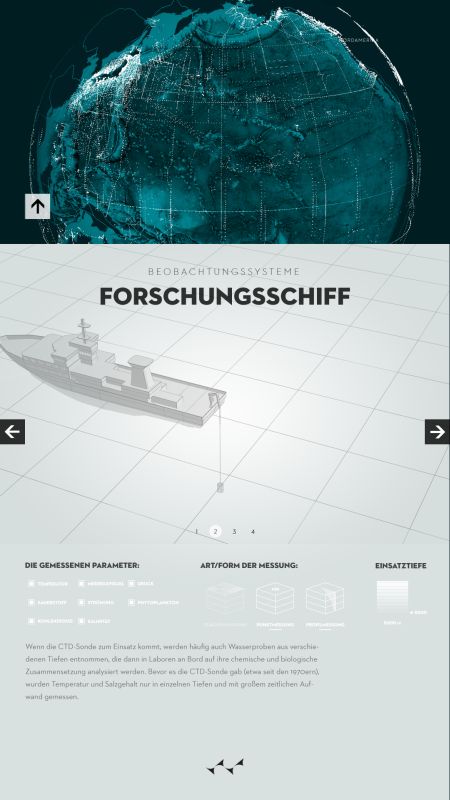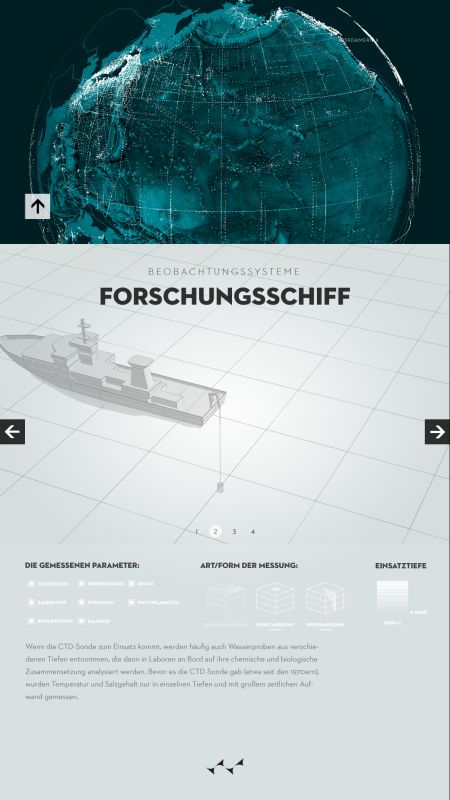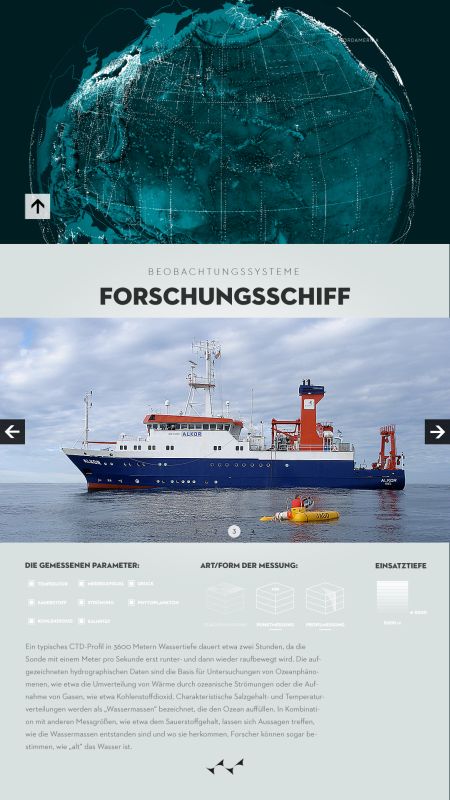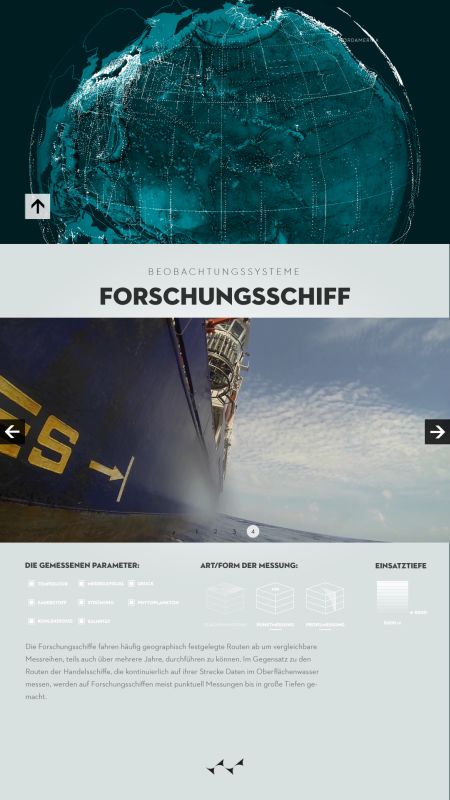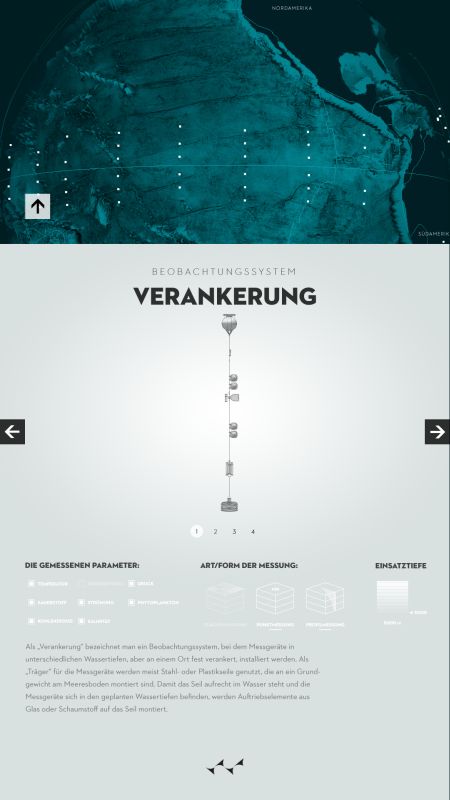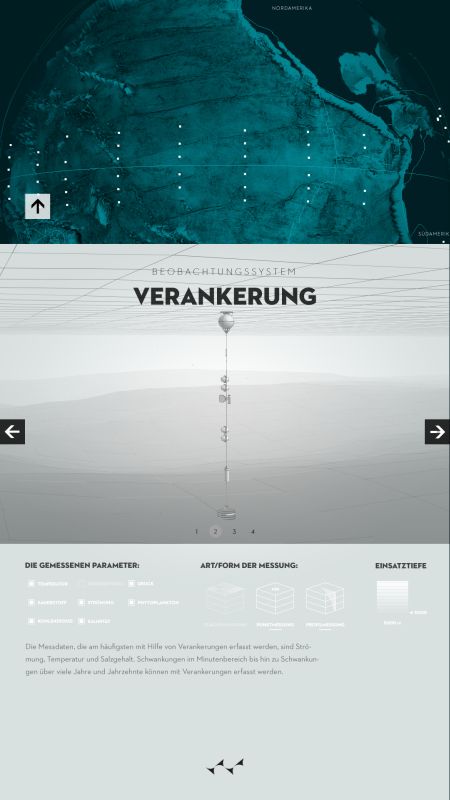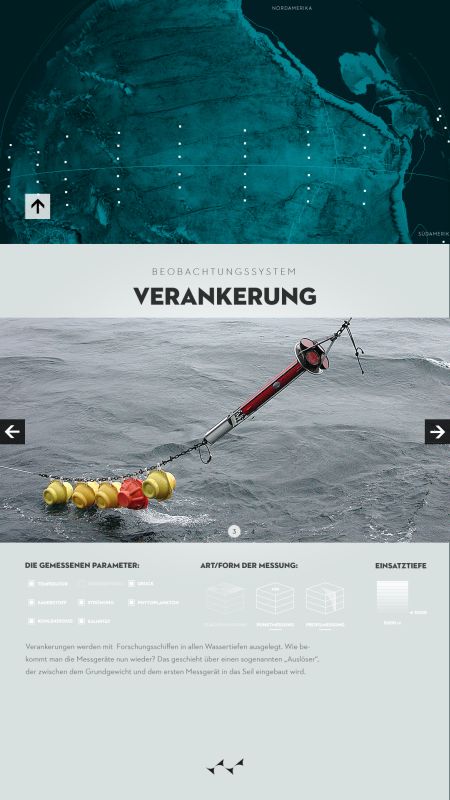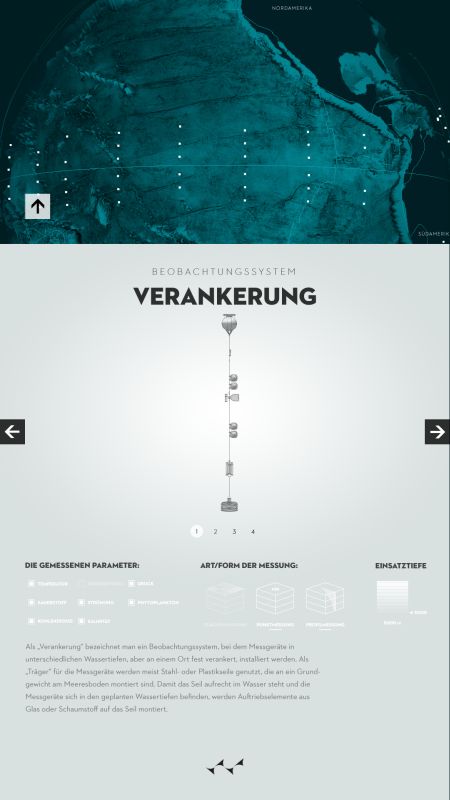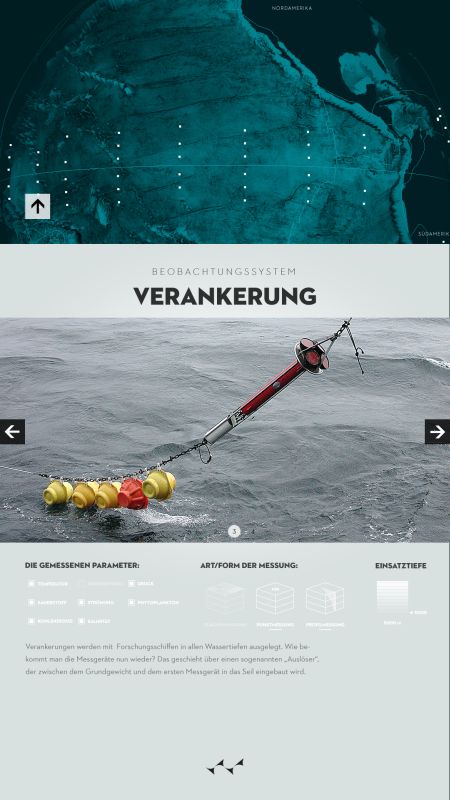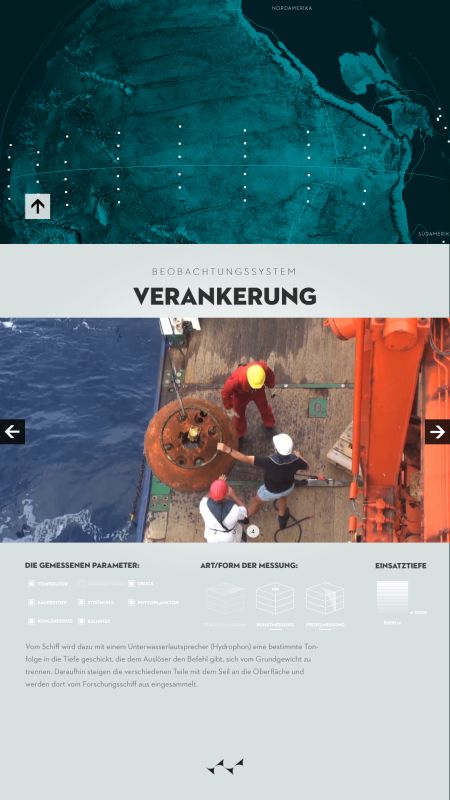The Future of Scientific Knowledge Transfer is Digital
The interactive poster is a gesturally operable multimedia exhibition object used for the transfer of complex scientific content. It consists of a 55 ̋ touchscreen – approximately the size of DIN A0 – which by means of gestural input can be navigated and provide individual access to content. The poster was created in the framework of a research project of the Muthesius Academy of Fine Arts & Design Kiel in cooperation with the Cluster of Excellence “The Future Ocean” in 2013.
The research focused on the question: Is the classic printed poster as medium of scientific knowledge transfer still up-to-date? Moreover: Does the poster apart from with its informative, enlightening and emancipatory traditions have potential for the development towards a flexibly operable and attractive medium? What possibilities do digital and interactive extensions provide to meet the requirements of an attractive and contemporary format for scientific knowledge transfer – for example with regard to the short update cycles and the huge amount of scientific content which is transferred nowadays? Last but not least: How does the medium which is being used change the understanding and effect of the transferred content?
topic "submarine landslides"
The focus of the first poster is on marine geology: seaquakes, submarine landslides and the tsunamis caused by them do not only pose an immediate danger. They have the potential to influence us on a long-term and global scale, as the examples of Sumatra 2004 and Japan 2011 have shown. Among the depictions there is a graph of the Storegga landslide: Through Frank Schätzing’s novel “Der Schwarm” this landslide became known outside the scientific community: About 8,000 years ago, a landslide about the size of Iceland caused a tsunami off the Norwegian coast and devastated large parts of Northern Europe. The digital poster depicts causes, mechanisms and effects of such slides and explains typical situations which can cause underwater landslides. With the help of the poster the researchers want to explain the processes behind the bigger landslides and depict the most important factors which lead to instable slopes and as a consequence to submarine landslides. The research of “Dangerous Ocean” is one of eleven research fields of the Cluster of Excellence “The Future Ocean”.
topic "Ocean observations"
."Ocean observation – from sensor to knowledge". This is the most recent topic explored interactively with the digital poster of the Future Ocean Cluster which is used for talks. Data collection can only be done with the help of observations, which are the most important cornerstone for developing our understanding of the ocean. Statements about ocean changes, the assessment of risks and potentials, but also possibilities to react to these, are ultimately based on precise observation and preferably accurate data. The methods for gathering data, data conversion and information processing are an essential point – since correct conclusions can only be drawn from the information gathered, when this is carried out correctly. The new digital Future Ocean Poster shows the systems with which the necessary information is gathered, but also how temperatures change over time periods in the global context.
DESIGN RESEARCH
The interactive poster was created in the framework of the core research area “scientific knowledge visualization” at the Muthesius Academy of Fine Arts & Design under the leadership of Prof. Tom Duscher. This core area investigates how multi-media presentations of knowledge serve not only as the basis for knowledge transfer but can also provide a framework for the acquisition of knowledge. The Muthesius Academy of Fine Arts & Design has set itself the task of finding artistic solutions to visual, communication and scenography questions in the area of knowledge presentation for several years.
PROJEcT TEAM
- Prof. Tom Duscher, Muthesius Academy of Fine Arts & Design [director]
- Konrad Rappaport [concept, design]
- Prof. Dr. Sebastian Krastel, CAU Kiel [scientific content]
- Dr. David Völker, GEOMAR [scientific content]
- Christian Engler [technical director]
- Jonas Häutle [technical development]
- Hermann Hartung [technical development]
- Louise Dölger [speaker English]
- Fabian Heinitz [speaker-recordings]
News
Next presentation
at the fair presentation of Kiel University at the Hannover Messe (April 2018)
Investigated:
Digital Interactive Poster Gets Good Ratings in Science Communication
The interactive digital poster on the topic "Tsunamis," developed in the Cluster of Excellence "Future Ocean" by SciComLab, was one of the exhibition modules of the floating science center "MS Wissenschaft" in the Science Year Seas and Oceans 2016 * 17 of the Federal Ministry of Education and Research. In order to examine the effect of the poster on visitors, including younger people and families with young children, the creators of the poster organized an evaluation by the National Institute for Science Communication (NAWiK). Four researchers and communicators, including Professor Sebastian Krastel from the Institute of Geosciences at Kiel University and Oskar Ohldorf from the GEOMAR Helmholtz Centre for Ocean Research Kiel, presented the contents of the poster on the MS Wissenschaft to a lay public.
The empirical study was conducted by the KIT junior research group "Science in Presentation." Within the framework of the reception study, the different components of the presentations and their influence on comprehensibility - in addition to the expectations and behaviors of the audience - were examined with the help of innovative scientific methods - from survey variants to eye tracking. Due to the small number of cases the project, funded by the Klaus Tschira Foundation gGmbH, does not allow representative statements, but can indicate tendencies within a limited scope. In the four analyzed lectures, a consistently positive response to the interactive poster was found.
In over 70% of the cases surveyed, the audience assessed the design of the thematic pages as well as the structuring of their content as at least "good". Also, the amount of text and the use of interactive elements and other images and graphics were rated by the vast majority (85 percent) as just right. The readability of different elements of the poster was perceived comparatively well by only half of the recipients. In the overall impression, around 75 percent of the participants gave the rating "good" or "very good". In particular, the "Repository Mode" was evaluated very positively, a presentation variant in which the presenter - instead of a prepared, classic PowerPoint presentation – makes use of several short presentations from multimodal pool of the interactive poster.
Detailed information about the evaluation can be found (in German) in:
Philipp Niemann, Christiane Hauser, Philipp Schrögel, Präsentation am „Interactive Scientific Poster" – Befragungsergebnisse im Rahmen einer Rezeptionsstudie, Science in Presentations Arbeitsberichte (SIP) #1Ausführliche Informationen zur Evaluierung in:
https://www.geistsoz.kit.edu/germanistik/downloads/SIP_Arbeitsberichte_1.pdf
The topic: Submarine landslides
Causes
The causes of slope instability and submarine landslides are sedimentation processes which lead to partly inhomogeneous and as a result unstable sediment layers. The poster allows the user to follow the footsteps of science to investigate different sedimentation processes at various locations in the ocean and to observe which types of sediments they produce. With the help of a vertical slider the user can break through the atmosphere and the water column and drill into the sediments. In animations and texts the respective ongoing processes are described.
Mechanisms
Which forces and mechanisms are of importance during a landslide? Users can get the answer to this question, e.g. by comparing patterns of different slides. With the help of physics calculated in real time it is possible to reconstruct the different conditions under which natural slopes are created.
Impact
Which impact can submarine slope slides have? The simulation of a potential landslide off Svalbard with the subsequent tsunami shows how a threat for the whole North Atlantic could develop as a consequence.
Statistics
Accurate statistics are necessary to answer the question of which regions are potentially threatened by tsunamis: Current scientific data, for example about sediment thickness, population density, continental and plate boundaries, and bathymetric data can then be compared to knowledge about historic tsunamis, earthquakes, slides and volcanic activities. In this manner a statistical aggregation for certain potentially threatened areas can be observed.
The topic: Ocean Observation
Ocean temperatures
Temperature is the parameter that has been most often measured and historically for the longest time. This provides an important indication in determining the condition of the oceans. On the globe, measured temperature data is presented in the course of time from 1889 until the present.
The clear increase in the density of data is shown by the visualization, triggered by modernized recording procedures and increased scientific interest. Moreover, the growing warming of the world's oceans, also as a reaction to global climate change is illustrated with colors. The data were gathered with the help of different procedures, such as floats (ARGO), satellites and measurement procedures on ships. The users can learn about this in more detail with the help of the digital poster.
ARGO
Argo floats are autonomous observation systems which do not have a motor but are propelled by the current at a drift depth of 1500 meters. Every ten days, the deep drifters produce a vertical profile of the temperature and salinity, starting from 2000 meters water depth up to the water surface. At the surface, the floats transmit data to a land station; there the speed of the current at the 1500 meter drift depth is also calculated from the spatial difference between the last dive and the resurfacing.
About 4000 Argo floats are in use worldwide. Thus, thanks to excellent international coordination, a nearly comprehensive profile of the world's oceans is developing, through which both long-term and large-scale changes can be observed and analyzed.
Ship (research vessel/ cargo vessel)
Research vessels are the all-rounders among the observation systems, since they can operate in nearly every corner of the oceans and, at the same time, very different measurement techniques can be used on them. In particular, multifunctional and accordingly frequently used, is the CTD probe. It measures salinity, temperature and pressure in all depths and can be expanded through other systems, for example, for taking water samples or measuring oxygen concentrations. The selective collection of data from research vessel is increasing by means of cargo vessels equipped with sensors, which gather data in the surface water on trade routes through the oceans.
Anchorage
Measurement systems which are fixed at different water depths through base weights are called anchorages. The attached steel and plastic ropes are kept perpendicular in the water column by means of floats; attached to these are sensors which mainly gather data on currents, temperature and salinity at the anchored depth. The measuring instruments are set out with the help of research vessels. In order to bring them back to the surface, a trigger mechanism is activated with the help of hydrophones and a certain tone sequence. This separates the base weight from the swimming unit, so that sensors, ropes and floats can be collected at the surface by the crew of the ship.
Award-winning:
Red Dot-Award „Best of the Best“ for interactive poster
The Muthesius Academy of Fine Arts and Design has received the internationally renowned Red Dot design award for the interactive digital poster used to communicate research topics for the Kiel Cluster of Excellence “The Future Ocean”, making them intuitively accessible on an 55-inch touch sensitive screen. The jury awarded the work of Tom Duscher’s team with the label “Best of the Best’’ for distinct design quality. The interactive scientific poster is thus among the entries which particularly impressed the jury with their uniqueness. The internationally renowned “Red Dot” design prizes are awarded annually by the Design Zentrum Nordrhein Westfalen, one of the oldest and most highly reputed design institutions in Europe.


German Design Award Gold for Muthesius University of Fine Arts and Design
The Muthesius University of Fine Arts and Design has received the German Design Award Gold 2016 for the interactive digital poster, used to convey research topics of the Kiel Cluster of Excellence "The Future Ocean." This is the second internationally renowned prize for the poster after the 2014 reddot award. More than 1,000 participants from the worlds of politics, business, design and the press follow the award ceremony every year, during which the German Design Council rewards innovative design and, for the German and international design landscape, groundbreaking products and projects. The special title German Design Award Gold is only awarded to the best of the best in every category of the German Design Award.
The first version of the "Next Generation Scientific Poster" project was presented at an international conference in autumn 2013 and has been further developed since then. Today the interactive science poster is used at marine science meetings and public events around the world.
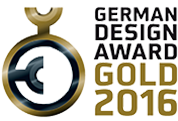

City of Kiel Innovation Prize
The presentation of the innovation prize was a premiere. For the first time ever, the City of Kiel awarded projects that particularly enhance the understanding of the City of Kiel through innovation. The prize went to Prof. Ronald Eisele from Kiel University of Applied Sciences and the Science Communication Lab from an offshoot from the Muthesius University of Fine Arts and Design. Tom Duscher, Professor of Interactive Media at the Muthesius University of Fine Arts and Design, founded the company together with his graduate students Konrad Rappaport and Herman Hartung. The interactive digital poster resulting from the partnership of the Muthesius University of Fine Arts and Design in the Cluster of Excellence "The Future Ocean" provides lay persons insight into complex scientific topics with the help of state-of-the-art technology and attractive design. The City of Kiel honored the special combination of research and art with the prize.
